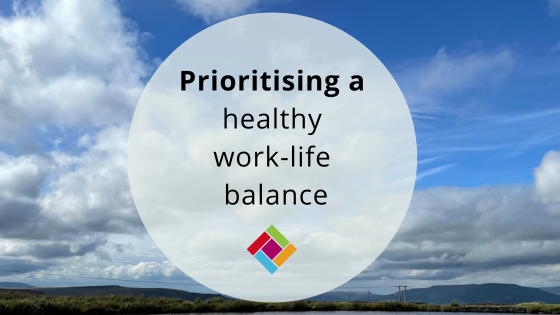
According to research, 31% of UK employees feel they do not have a good work-life balance. What’s more, 50% of all employees who switched jobs in 2022 did so to achieve a better work-life balance.
In the UK, where employees work the longest hours in Europe, achieving a healthy employee work-life balance is no longer a nice to have, but it is crucial for managers to include in an HR strategy.
According to Mental Health UK’s Burnout Report, nearly half of UK working adults say their employer doesn’t have a plan to spot the signs of chronic stress and prevent burnout in their employees.
So how can employers help employees achieve a work-life balance, and what policy and practical changes are needed?
Understanding the importance of a healthy employee work-life balance
Work-life balance refers to the equilibrium between professional responsibilities and personal life activities. According to Mental Health UK, just one employee experiencing a mental health condition can cost UK businesses an average of £1,035 annually. This can be as a result of sickness absence, reduced productivity and staff turnover. The Burnout Report also revealed that 20% of workers in the UK needed to take time off work in the past year due to poor mental health caused by pressure or stress. That’s one in five experiencing burnout.
There are numerous other reasons why achieving a healthy employee work-life balance is essential:
- Enhanced productivity. Staff who feel balanced and fulfilled outside of work are more likely to bring their best selves to work.
- Reduce the risk of burnout. The Burnout Report cites high workloads, job insecurity and bullying in the workplace as all contributing factors to the risk of employee burnout. You should also consider how you can deal with workplace cliques.
- Improve staff health and wellbeing. Chronic stress can have a direct impact on health, which leads to more time off sick.
- Attracting and retaining good talent. Millennials and Gen Z job seekers are now motivated by company culture and a healthy work-life balance more than salary. What’s more, employees who feel supported in the workplace are more likely to stay with a business longer term.
What policy changes are needed?
Support across businesses for employees varies according to sector. The Burnout Report suggests that IT and telecoms and medical and health services had the highest number of employer plans to help colleagues spot signs of chronic stress and present burnout. However, retail scored the lowest with over half recognising that their employer did not have any plans in place.
There are numerous ways employers can help staff achieve a healthy work-life balance, and should be reflected in the company policies.
Wellbeing policies
A wellbeing policy shows staff that the business cares for them and their wellbeing is taken seriously. We have a free policy template you can download here.
Wellness programmes / EAP schemes.
Invest in wellness programmes for staff – these could be discounted gym memberships or subscriptions or access to EAP resources offering wellbeing advice and guidance. We work with Wellness Cloud and Hospitality Action is a celebrated EAP system specifically focused on the hospitality industry.
Flexible working arrangements.
Offering any flexible working arrangement can help to attract and retain staff. Options include flexible hours, compressed working or job sharing allowing staff to better manage their work-life balance. In retail and hospitality, consider flexible shift patterns that allow staff adequate time off.
From 2024, employees will now be able to request flexible working from the first day of employment so it’s essential to have a policy that reflects the company’s stance on this.
Compassionate leave and menopause policies.
Having these policies in place also demonstrate that employees’ wellbeing is considered. For more information on how to write a menopause policy, read our guide here.
Training and development.
Are your managers trained to effectively manage workloads, delegate tasks and recognise the signs of burnout and stress in employees?
Sickness and absence policy.
Ensure that this is up to date with employment law and make sure that staff are aware of the policy and their obligations.
Parental leave policy.
These are designed to support parents during times of transition. Keep up to date with changes in employment law with regard to these policies.
Practical tips
In addition to the policy changes, incorporating practical strategies into daily operations can help to support a healthy work-life balance. These include.
- Set clear expectations and boundaries: leading by example is a great way to showcase company culture. Managers should exemplify a healthy work-life balance and demonstrate how work can be managed. Setting boundaries will help staff to understand what’s expected and manage within those parameters.
- Communication: scheduling regular check-ins and one-to-ones between managers and staff can avoid employees feeling overwhelmed or isolated. Establish clear channels of communication so that staff also feel they can flag issues or talk to a manager if they need to discuss anything that’s worrying them.
- Celebrate success – company culture session: recognising and rewarding staff for achievements goes a long way in motivating employees. This can be done through a reward scheme, or during company culture days or offsite events (read our guide to hosting a company culture day). A lot of businesses forget to show appreciation and thank their employees.
- Reduce isolation: if your workforce is hybrid, it’s essential to ensure staff don’t feel isolated or working in silos. Regular team meetings can help bring a sense of cohesion to the team.
Remember, investing in a healthy work-life balance isn’t just beneficial for your employees, it’s a strategic decision that will benefit the business’s success.
For more support with managing your team from our experienced HR Consultants, you can find out how to work with Bespoke HR here.